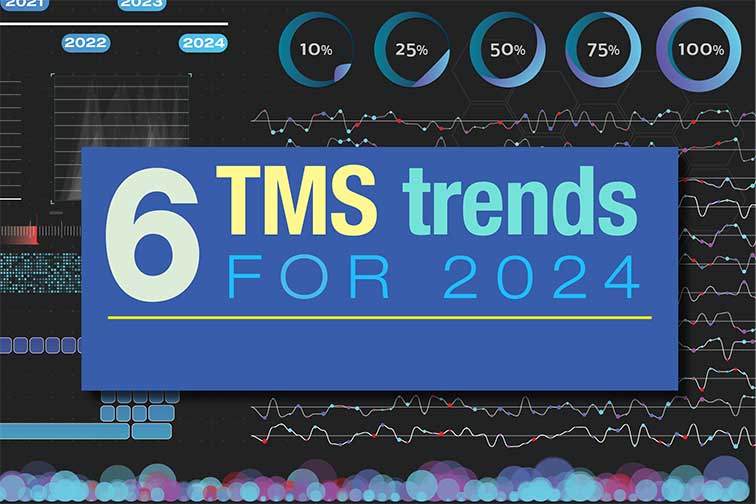6 TMS Trends for 2024
Our top supply chain software analysts share the TMS trends they believe shippers need to be paying attention to during the coming year.
The transportation landscape has become pretty complex over the last couple of years. Fluctuating rates, capacity constraints, the persistent truck driver shortage, Yellow’s bankruptcy and myriad other events have all pushed transportation and logistics optimization further out of reach for many companies.
Changing customer expectations—namely, delivery times—are also putting more pressure on shippers to tighten up their transportation management approaches. In response, more companies are turning to technology to help them reduce costs, improve visibility, enhance productivity and make better decisions.
That’s where transportation management systems (TMS) come in. A longtime favorite of transportation, logistics and supply chain managers, TMS offers the shipment planning, shipment execution, carrier management, inventory management and reporting that companies need to be able to streamline their supply chains.
The software automates many tasks that would otherwise be handled manually (e.g., routing and scheduling) and helps companies identify and address costly problems like inefficient routing.
Transportation management systems are known for offering a strong return on investment (ROI) and rank as one of the most-used supply chain software suites. Most companies buy TMS for the freight savings generated by the software’s simulation and network design, load consolidation, lower-cost mode selection, and multi-stop route optimization capabilities.
As freight costs have continued to rise, companies have looked more and more to their TMS to mitigate these rising costs. “Planning and execution solutions can significantly reduce freight costs while improving service levels,” says Chris Cunnane, research director, supply chain management, at ARC Advisory Group. He says the TMS market has shown steady growth over the last few years—a growth trajectory that’s expected to continue.
“The pandemic pushed e-commerce to levels that were unfathomable in early-2020,” says Cunnane. “This trend has continued through 2023, especially as those who may have been reluctant to shop online have experienced the ease and convenience associated with it. While this put an added strain on shippers and carriers to fulfill customer orders and meet expectations, it’s a boon to the TMS market as retail, consumer packaged goods [CPG], and food and beverage companies, in particular, look to meet growing demand.”
When it comes to software delivery, the TMS market has largely moved into the cloud, where software-as-a-service (SaaS) stands as “the most important market dynamic in TMS,” according to Cunnane. “Suppliers that have fully made the transition to SaaS, and no longer or only reluctantly sell in the software license model, are growing much faster than their competitors.”
As shippers lay out their transportation plans for the coming year, here are six more TMS trends to watch, plan for and take advantage of.
1
Real-time visibility solutions wanted. As he surveys the transportation landscape, Cunnane sees more companies seeking out real-time visibility solutions to help them better manage both transportation operations. Some vendors are stepping up to the plate, while others are in the early stages of embedding real-time visibility into their solutions. Cunnane says the urgency is palpable in this particular area.
“TMS suppliers need to either develop these solutions or partner with a real-time visibility provider,” he points out. “There’s been more interest from outside investors in this technology, and [we] anticipate a series of acquisitions in the visibility space in the near term.”
Real-time visibility solutions are important in that they raise the prospect that machine learning can be used to improve estimated times of arrival (ETAs). “But unless a TMS provider has access to network transportation data, like public cloud providers do,” Cunnane continues, “the visibility provider will be in a better position to use artificial intelligence (AI) to provide these enhanced ETAs than a TMS provider.”
“Unless a TMS provider has access to network transportation data, like public cloud providers do, the visibility provider will be in a better position to use artificial intelligence [AI] to provide these enhanced ETAs than a TMS provider.” — Chris Cunnane, ARC Advisory Group
2
More machine learning finds its way into TMS. Machine learning helps shippers save money, optimize their operations and provide higher levels of customer service. It’s also helping companies deal with labor constraints and redeploy human labor to more important and strategic projects.
For example, machine learning algorithms can analyze historical data (e.g., seasonal patterns and economic indicators) to forecast future demand for goods and services. They’re also being used to analyze real-time traffic data, road closures and inclement weather to optimize delivery routes.
Machine learning can also help companies manage tasks like last-mile routing—a job that takes time to do and that’s dependent not just on the miles that need to be driven but also on the congestion, the type of product being delivered, the type of residence, and whether value-added services are being provided at the destination.
“Machine learning can be used to ‘learn’ these constraints,” says Cunnane, “rather than having to do time studies and hard code these constraints into the solution.”
3
Shippers are looking for faster and faster ROI. Depending on who you ask, the average new TMS user can shave anywhere from 5% to 15% off its annual freight costs when it starts using the software.
Brocks Johns, senior principal analyst in the logistics and customer fulfillment team at Gartner, Inc., says shippers want to hit those marks faster than ever as they wrestle with the constraints and complications of the modern freight market.
Johns says companies have gone back to the pre-pandemic days of developing business cases and determining ROI targets before investing in any new software solutions.
“For a couple of years these companies were seemingly handing out blank checks for those purchases,” says Johns. “Now, TMS is back to competing with warehouse management systems (WMS) and other systems for those dollars.”
Some vendors have taken the cue and are now doing more on the sales side to position their solutions as the de facto choice among TMS systems. Others are still operating as if the pandemic buying craze was in full swing. “In general, we’re seeing a shift to vendors becoming more flexible and helpful, and some are just better at doing that than others,” says Johns.
4
All eyes are on sustainability. Implementing sustainable practices helps reduce their environmental impact, conserve resources and minimize waste.
With transportation accounting for the largest portion (29%) of total U.S. greenhouse gas (GHG) emissions, it’s no surprise that companies are looking especially hard at their transportation operations for new ways to decrease their carbon footprints.
“Interest in sustainability continues to go up across the board,” says Johns, whose recent research unveiled a vendor pool that wants to help in this area.
For example, more TMS solutions are offering the key performance indicators (KPIs) and reporting that companies need to be able to track, monitor and adjust their transportation strategies.
Johns says some TMS vendors—European companies, in particular—are exploring partnerships, adopting frameworks and developing standard methodologies for calculating the environmental impacts of certain transportation options.
“We’ve seen a lot of activity in this area and mainly in response to companies’ requests for these capabilities,” says Johns. “Transportation leaders are working to get ahead of any potential regulations.”
Amarendra Phadke, CTO, North American consumer products and retail practice at Capgemini Engineering, is witnessing a similar trend and expects it to continue through 2024 and beyond. He says that transportation mode selection is one area that’s ripe for more TMS support in the sustainability realm. “As the overall environment is changing around us, we’re seeing more and more conversations about solutions that help reduce our carbon footprints,” says Phadke.
5
Predictive, prescriptive and descriptive analytics are all the rage. Phadke is also seeing more advanced features related to freight sourcing integrated into TMS solutions through the use of application programming interfaces (APIs). For example, he says shippers want to be able to plan and incorporate transportation and execution with their suppliers, vendors and customers.
Companies also want better data visibility made possible by predictive (for forecasting), prescriptive (recommends a course of action) and descriptive (dissects past, current and future trends) analytics.
Based on existing data and integrating several different data sources, these analytics are helping shippers more effectively manage and address the many scenarios that can surface as shipments make their way from origin to destination.
6
Transportation management systems go mobile. Looking out a bit further into the future, the time may be coming when more transportation and logistics managers use their smartphones to run their transportation networks.
This is already happening at some organizations, where TMS is being served up as an app on the manager’s smartphone. As younger, “digitally native” employees make their way into the workforce, they won’t want to be tied to a desk or laptop all day. Mobile TMS helps to solve this problem while also allowing managers to make important transportation decisions on the fly.
“In 2023, we saw more focus from several vendors on mobile applications than we saw in the past,” says Johns. Presently, most of those mobile apps can handle simple tasks, like showing the status of a particular shipment or alerting a user about a potential shipment delay. Johns says some TMS vendors have expanded beyond the basics and now offer “TMS in your hand” functionalities that allow users to get even more done—booking shipments, looking up rates—on their phones or tablets.
Will the mobile TMS trend continue? Johns thinks so. He also expects more vendors to tweak their user interfaces to make them more “mobile-like” in order to accommodate the incoming, tech-savvy workforce.
“I don’t think this is happening by accident,” Johns points out. “It’s likely in response to the changes in workforce demographics, so we’ll probably see more of it going forward.”













